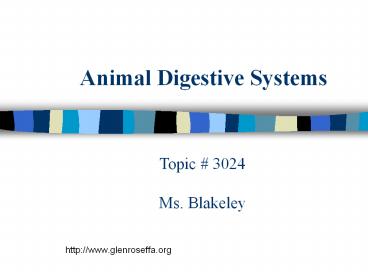Animal Digestive Systems - PowerPoint PPT Presentation
1 / 15
Title:
Animal Digestive Systems
Description:
Digestive System Where large complex molecules are broken down into simpler molecules Digestive Tract: Long tube beginning with mouth and ending with the anus ... – PowerPoint PPT presentation
Number of Views:470
Avg rating:3.0/5.0
Title: Animal Digestive Systems
1
Animal Digestive Systems
Topic 3024Ms. Blakeley
- http//www.glenroseffa.org
2
Digestive System Objectives
- Describe and understand the basic functions of
the primary components of the digestive system. - Compare the functions and locations of the
digestive organs in man, poultry, horses, cows
and swine. - Differentiate between and identify digestive
systems of man, horses, swine, poultry and cows.
3
Digestive System
- Where large complex molecules are broken down
into simpler molecules - Digestive Tract
- Long tube beginning with mouth and ending with
the anus - Polygastric (Ruminant)
- A stomach with more than one compartment
- (cows, sheep, deer)
- Monogastric (Non-ruminant)
- A stomach with one compartment
- (swine, horses)
- Avian (Poultry)
- No true stomach
- (chickens, geese)
4
Digestive Systems
- Man Pig have a simple stomach with an extensive
intestinal system - Horses Rabbits have a simple stomach with an
extensive intestinal system and an enlarged
caecum - Ruminants have a complex stomach with a simpler
intestinal system - Poultry have no teeth and no true stomach with a
crop and gizzard to grind food
5
Mouth Esophagus
- Mouth prehensile tool (grasps mixes food)
- Chewing breaks down food
- Salivary Glands secrete juices containing enzymes
(digest food) - Mucin lubricates the feed for swallowing
- Esophagus muscular tube that connects mouth to
stomach - Peristaltic waves send feed down the esophagus,
(muscle contractions). - Reverse Peristalsis blowing chunks
- The cardia, located at the end of the esophagus
prevents feed in the stomach from coming back
into the esophagus. ( non-ruminants only)
6
Simple Stomach
- Muscular organ, receives feed
- Gastric juices are secreted by the glands in the
stomach wall - start when masticated feed enters the stomach
- Gastric juices have about 0.2 to 0.5 percent HCl
- The wall of the stomach is lined with muscle,
this muscle churns and squeezes the feed - This action forces the liquid portion on into the
small intestine
7
(No Transcript)
8
Ruminant Stomach
- Occupies 3/4 of abdominal cavity, mostly on the
left side - Rumen (paunch) 80 of stomach, lighter food
collects here - Microbes digest cellulose
- Uses lots of water
- Reticulum (hardware stomach) 5 of stomach,
heavy foreign items are trapped here
9
Ruminant Stomach (cont.)
- Omasum (many plies) 8 of stomach, absorbs water
- Abomasum (true stomach) 7 of stomach, typical
enzyme activity - Rumination regurgitation, re-chewing of food
10
Rumination (regurgitation)
- After rumen if full, it lies down to ruminate
(chew its cud) - Cattle spend from 5-7 hours ruminating, broken up
into 6-8 periods - Regurgitation is the process of forcing the feed
back into the mouth for chewing - Done through a series of muscular contractions
and pressure in the rumen and reticulum
11
(No Transcript)
12
Avian stomach/gizzard
- Since chickens have no teeth, they swallow food
whole and its stored in the crop - Feed in proventriculus are secreted by the
glandular stomach and mixed with feed - The feed moves to the gizzard and is ground
- Epithelium breaks the feed into smaller
particles, further mixing proventricular digestie
juices with the feed in the gizzard - The end of the digestive system is the vent
13
(No Transcript)
14
Small Large Intestines
- Small Intestine long coiled tube connecting
stomach to large intestine - rest of the digestion and absorption takes place
here - surface covered with villi (surface area)
- Large Intestine Caecum, colon, rectum
- absorbs water (makes feces more solid)
- some vitamins minerals absorbed here
- Cecal Fermenters (Horse) similar to rumen
15
(No Transcript)































